Preparation, Structure, Function, and Application of Dietary Polysaccharides from Polygonatum sibiricum in the Food Industry: A Review
Abstract
1. Introduction
2. Preparation Process of Dietary Polysaccharides from Polygonatum sibiricum
2.1. Study on Extraction Technology of Dietary Polysaccharides from Polygonatum sibiricum
2.1.1. Extraction of Polygonatum sibiricum Polysaccharides via the Physical Method
Ultrasonic-Assisted Extraction
Microwave-Assisted Extraction
Freeze–Thaw Extraction Method
2.1.2. Chemical Extraction of Polysaccharides from Polygonatum sibiricum
Hot Water Extraction
Natural Deep Eutectic Solvent Extraction Method
2.1.3. Enzyme-Assisted Extraction
2.2. Study on Separation Technology of Dietary Polysaccharides from Polygonatum sibiricum
2.3. Study on Purification Technology of Polygonatum sibiricum Dietary Polysaccharides
3. Structural Characterization of Polygonatum sibiricum Dietary Polysaccharides
3.1. Determination of Molecular Weight
3.2. Analysis of Constituent Monosaccharides
3.3. Glycoside Bonds of Polygonatum sibiricum Dietary Polysaccharides
4. Pharmacological Activity of Polygonatum sibiricum Dietary Polysaccharides
4.1. Hypoglycemic Activity
4.2. Antioxidant Activity
4.3. Immunomodulatory Activity
4.4. Anti-Osteoporosis Activity
4.5. Antidepressant Activity
4.6. Liver-Protecting Activity
4.7. Other Activities
5. Application Status of Polygonatum sibiricum Dietary Polysaccharides in Food and Other Fields
5.1. Food Field
5.1.1. Drinks
5.1.2. Functional Food
5.2. Food Packaging
5.3. Cosmetic Field
5.4. Animal Feed Field
6. Conclusions and Expectations
Author Contributions
Funding
Institutional Review Board Statement
Informed Consent Statement
Data Availability Statement
Acknowledgments
Conflicts of Interest
References
- He, Y.; Chen, Z.; Nie, X.; Wang, D.; Zhang, Q.; Peng, T.; Zhang, C.; Wu, D.; Zhang, J. Recent Advances in Polysaccharides from Edible and Medicinal Polygonati Rhizoma: From Bench to Market. Int. J. Biol. Macromol. 2022, 195, 102–116. [Google Scholar] [CrossRef]
- He, S.; Wang, X.; Chen, J.; Li, X.; Gu, W.; Zhang, F.; Cao, G.; Yu, J. Optimization of the Ultrasonic-Assisted Extraction Technology of Steroidal Saponins from Polygonatum kingianum Collett & Hemsl and Evaluating Its Quality Planted in Different Areas. Molecules 2022, 27, 1463. [Google Scholar] [CrossRef] [PubMed]
- Zhang, H.; Hao, F.; Yao, Z.; Zhu, J.; Jing, X.; Wang, X. Efficient Extraction of Flavonoids from Polygonatum sibiricum Using a Deep Eutectic Solvent as a Green Extraction Solvent. Microchem. J. 2022, 175, 107168. [Google Scholar] [CrossRef]
- Chen, H.; Li, Y.-J.; Li, X.-F.; Sun, Y.-J.; Li, H.-W.; Su, F.-Y.; Cao, Y.-G.; Zhang, Y.-L.; Zheng, X.-K.; Feng, W.-S. Homoisoflavanones with Estrogenic Activity from the Rhizomes of Polygonatum sibiricum. J. Asian Nat. Prod. Res. 2018, 20, 92–100. [Google Scholar] [CrossRef] [PubMed]
- Yang, M.; Chen, R.; Zhou, X.; Chen, H. Research Progress on Pharmacological Effects and Mechanism of Polygonatum sibiricum Polysaccharides. Starch Stärke 2024, 76, 2300168. [Google Scholar] [CrossRef]
- Chang, L.; Goff, H.D.; Ding, C.; Liu, Q.; Zhao, S.; Tao, T.; Lu, R.; Gao, Y.; Wu, H.; Guo, L. Enhanced Hypoglycemic Effects of Konjac Glucomannan Combined with Polygonatum cyrtonema Hua Polysaccharide in Complete Nutritional Liquid Diet Fed Type 2 Diabetes Mice. Int. J. Biol. Macromol. 2024, 266, 131121. [Google Scholar] [CrossRef] [PubMed]
- Chen, N.; Ding, Y.; Li, X.; Li, J.; Cheng, Y.; Tian, Y.; Tian, Y.; Wu, M. Chemical Structures and Immunomodulatory Activities of Polysaccharides from Polygonatum kingianum. Int. J. Biol. Macromol. 2024, 279, 135406. [Google Scholar] [CrossRef] [PubMed]
- Wang, S.; Li, G.; Zhang, X.; Wang, Y.; Qiang, Y.; Wang, B.; Zou, J.; Niu, J.; Wang, Z. Structural Characterization and Antioxidant Activity of Polygonatum sibiricum Polysaccharides. Carbohydr. Polym. 2022, 291, 119524. [Google Scholar] [CrossRef] [PubMed]
- Huang, Z.; Du, X.; Ma, C.; Zhang, R.; Gong, W.; Liu, F. Identification of Antitumor Active Constituents in Polygonatum sibiricum Flower by UPLC-Q-TOF-MSE and Network Pharmacology. ACS Omega 2020, 5, 29755–29764. [Google Scholar] [CrossRef] [PubMed]
- Kuang, S.; Liu, Z.; Liu, L.; Fu, X.; Sheng, W.; Hu, Z.; Lin, C.; He, Q.; Chen, J.; Gao, S. Polygonatum sibiricum Polysaccharides Protect against Knee Osteoarthritis by Inhibiting the TLR2/NF-κB Signaling Pathway In Vivo and In Vitro. Int. J. Biol. Macromol. 2024, 274, 133137. [Google Scholar] [CrossRef]
- Zhang, Y.; Sun, Y.; Liu, Y.; Liu, J.; Sun, J.; Liu, X.; Fan, B.; Lu, C.; Wang, F. Polygonum sibiricum Polysaccharides Exert the Antidepressant-like Effects in Chronic Unpredictable Mild Stress-induced Depressive Mice by Modulating Microbiota-gut-brain Axis. Phytother. Res. 2023, 37, 3408–3423. [Google Scholar] [CrossRef] [PubMed]
- Liu, X.; Wan, Z.; Shi, L.; Lu, X. Preparation and Antiherpetic Activities of Chemically Modified Polysaccharides from Polygonatum cyrtonema Hua. Carbohydr. Polym. 2011, 83, 737–742. [Google Scholar] [CrossRef]
- Luo, Y.; Fang, Q.; Lai, Y.; Lei, H.; Zhang, D.; Niu, H.; Wang, R.; Song, C. Polysaccharides from the Leaves of Polygonatum sibiricum Red. Regulate the Gut Microbiota and Affect the Production of Short-Chain Fatty Acids in Mice. AMB Express 2022, 12, 35. [Google Scholar] [CrossRef]
- Luo, S.; Zhang, X.; Huang, S.; Feng, X.; Zhang, X.; Xiang, D. A Monomeric Polysaccharide from Polygonatum sibiricum Improves Cognitive Functions in a Model of Alzheimer’s Disease by Reshaping the Gut Microbiota. Int. J. Biol. Macromol. 2022, 213, 404–415. [Google Scholar] [CrossRef] [PubMed]
- Shi, Y.; Si, D.; Chen, D.; Zhang, X.; Han, Z.; Yu, Q.; Liu, J.; Si, J. Bioactive Compounds from Polygonatum Genus as Anti-Diabetic Agents with Future Perspectives. Food Chem. 2023, 408, 135183. [Google Scholar] [CrossRef]
- Hu, Y.; Tang, Y.; Zhang, Z.; Guo, X.; Wu, Z.; Li, Z.; Yu, H.; Li, W. Recent Advances in Polysaccharides from the Genus Polygonatum: Isolation, Structures, Bioactivities, and Application. Food Hydrocoll. 2023, 140, 108634. [Google Scholar] [CrossRef]
- Yang, M.-H.; Zhou, X.; Yang, Y.; Chen, H.-G. Effects of Different Extraction Methods on the Structural Characterization and Bioactivities of Polysaccharides Extracted from Polygonatum sibiricum. Food Meas. 2024, 18, 940–954. [Google Scholar] [CrossRef]
- Liu, J.; Zhang, Z.; Huai, X.; Wei, Y.; Zhu, J.; Li, X.; Xu, P.; Ijabadeniyi, O.A. Development and Application of the New Integrated Equipment and Process of the Nine-Steam-Nine-Bask Method in the Processing of Polygonatum cyrtonema. Processes 2022, 10, 1044. [Google Scholar] [CrossRef]
- Chen, J.; Xu, Y.; Tan, Z. CO2-Triggered Switchable Hydrophilicity Solvent as a Recyclable Extractant for Ultrasonic-Assisted Extraction of Polygonatum sibiricum Polysaccharides. Food Chem. 2023, 402, 134301. [Google Scholar] [CrossRef] [PubMed]
- Chen, Y.; Yu, H.; Liu, Y.; Guo, Y.; Wang, X.; Wang, Y.; Li, C.; Dong, Y.; Guo, Y. Ionic Liquid Ultrasound-Assisted Hydrodistillation High Efficiency Extraction of Turmeric (Curcuma longa L.) Essential Oil and Study of Its Extraction Mechanism. Sep. Purif. Technol. 2025, 359, 130504. [Google Scholar] [CrossRef]
- Jing, Y.; Yan, M.; Zhang, H.; Liu, D.; Qiu, X.; Hu, B.; Zhang, D.; Zheng, Y.; Wu, L. Effects of Extraction Methods on the Physicochemical Properties and Biological Activities of Polysaccharides from Polygonatum sibiricum. Foods 2023, 12, 2088. [Google Scholar] [CrossRef] [PubMed]
- Wang, Z.; Wu, S.; Wang, J.; Yang, C.; Wang, Y.; Hu, Z.; Cai, W.; Liu, L. Optimization of Polysaccharide Extraction from Polygonatum cyrtonema Hua by Freeze–Thaw Method Using Response Surface Methodology. Molecules 2024, 29, 4879. [Google Scholar] [CrossRef] [PubMed]
- Bu, Y.; Yin, B.; Qiu, Z.; Li, L.; Zhang, B.; Zheng, Z.; Li, M. Structural Characterization and Antioxidant Activities of Polysaccharides Extracted from Polygonati Rhizoma Pomace. Food Chem. X 2024, 23, 101778. [Google Scholar] [CrossRef]
- Zhang, R.; Yang, X.; Liu, Y.; Hu, J.; Hu, K.; Liu, Y.; Deng, Q.; Yang, S.; Hao, F.; Wen, X. Investigation of Natural Deep Eutectic Solvent for the Extraction of Crude Polysaccharide from Polygonatum kingianum and Influence of Metal Elements on Its Immunomodulatory Effects. Talanta 2024, 271, 125721. [Google Scholar] [CrossRef]
- Sun, C.; Wang, G.; Sun, J.; Yin, J.; Huang, J.; Li, Z.; Mu, D.; He, M.; Liu, T.; Cheng, J.; et al. A New Method of Extracting Polygonatum sibiricum Polysaccharide with Antioxidant Function: Ultrasound-Assisted Extraction-Deep Eutectic Solvents Method. Foods 2023, 12, 3438. [Google Scholar] [CrossRef]
- Tang, D.-X.; Zhou, S.-Z.; Wang, Z.-J.; Zhang, Y.-L.; Liu, K.; Yang, J.-Y.; Yang, X.-J.; Li, Y.-S.; Zhang, X. Efficiently Radiation-Induced Degradation and Extraction of Polygonatum sibiricum Polysaccharides and Its Excellent ROS Scavenging Properties. Chem. Eng. J. 2025, 505, 159717. [Google Scholar] [CrossRef]
- Zhang, H.; Cai, X.; Tian, Q.; Xiao, L.; Zeng, Z.; Cai, X.; Yan, J.; Li, Q. Microwave-Assisted Degradation of Polysaccharide from Polygonatum sibiricum and Antioxidant Activity. J. Food Sci. 2019, 84, 754–761. [Google Scholar] [CrossRef] [PubMed]
- Zuo, J.; Liu, W.; Tian, L.; Wang, M.; Liu, C.; Wang, M.; Fang, Z.; Han, J.; Wang, G.; Yin, Q. Extraction Optimization, Antioxidants, and Lipid-Lowering Activities of Polygonatum cyrtonema Hua Polysaccharides. CyTA—J. Food 2024, 22, 2310071. [Google Scholar] [CrossRef]
- Cheng, Y.; Huang, X.; Li, L.; Liu, L.; Zhang, C.; Fan, X.; Xie, Y.; Zou, Y.; Geng, Z.; Huang, C. Effects of Solid Fermentation on Polygonatum cyrtonema Polysaccharides: Isolation, Characterization and Bioactivities. Molecules 2023, 28, 5498. [Google Scholar] [CrossRef] [PubMed]
- Xu, Y.; Xu, J.; Fan, Z.; Zhang, S.; Wu, Y.; Han, R.; Yu, N.; Tong, X. Effective Separation of Protein from Polygonatum cyrtonema Crude Polysaccharide Utilizing Ionic Liquid Tetrabutylammonium Bromide. Front. Chem. 2024, 11, 1287571. [Google Scholar] [CrossRef]
- Wang, Y.; Li, F.; Huang, M. Deproteinization of Polygonatum sibiricum Polysaccharide and Its Antioxidant Activity. Food Ind. 2021, 42, 57–62. [Google Scholar]
- Wang, Y.; Niu, H.; Ma, Y.; Yuan, G. Isolation, Purification, Fractionation, and Hepatoprotective Activity of Polygonatum Polysaccharides. Molecules 2024, 29, 1038. [Google Scholar] [CrossRef] [PubMed]
- Li, L.-X.; Feng, X.; Tao, M.-T.; Paulsen, B.S.; Huang, C.; Feng, B.; Liu, W.; Yin, Z.-Q.; Song, X.; Zhao, X.; et al. Benefits of Neutral Polysaccharide from Rhizomes of Polygonatum sibiricum to Intestinal Function of Aged Mice. Front. Nutr. 2022, 9, 992102. [Google Scholar] [CrossRef] [PubMed]
- Li, M.; Liu, Y.; Zhang, H.; Liu, Y.; Wang, W.; You, S.; Hu, X.; Song, M.; Wu, R.; Wu, J. Anti-Cancer Potential of Polysaccharide Extracted From Polygonatum sibiricum on HepG2 Cells via Cell Cycle Arrest and Apoptosis. Front. Nutr. 2022, 9, 938290. [Google Scholar] [CrossRef]
- Li, R.; Tao, A.; Yang, R.; Fan, M.; Zhang, X.; Du, Z.; Shang, F.; Xia, C.; Duan, B. Structural Characterization, Hypoglycemic Effects and Antidiabetic Mechanism of a Novel Polysaccharides from Polygonatum Kingianum Coll. et Hemsl. Biomed. Pharmacother. 2020, 131, 110687. [Google Scholar] [CrossRef]
- Wen, R.; Luo, L.; Zhang, R.; Zhou, X.; Wang, W.; Gong, L. Structural Characterization of Polygonatum cyrtonema Polysaccharide and Its Immunomodulatory Effects on Macrophages. Molecules 2024, 29, 2076. [Google Scholar] [CrossRef]
- Zhang, J.; Chen, H.; Luo, L.; Zhou, Z.; Wang, Y.; Gao, T.; Yang, L.; Peng, T.; Wu, M. Structures of Fructan and Galactan from Polygonatum cyrtonema and Their Utilization by Probiotic Bacteria. Carbohydr. Polym. 2021, 267, 118219. [Google Scholar] [CrossRef]
- Wu, W.; Huang, N.; Huang, J.; Wang, L.; Wu, L.; Wang, Q.; Zhao, H. Effects of the Steaming Process on the Structural Properties and Immunological Activities of Polysaccharides from Polygonatum cyrtonema. J. Funct. Foods 2022, 88, 104866. [Google Scholar] [CrossRef]
- Shen, W.-D.; Li, X.-Y.; Deng, Y.-Y.; Zha, X.-Q.; Pan, L.-H.; Li, Q.-M.; Luo, J.-P. Polygonatum cyrtonema Hua Polysaccharide Exhibits Anti-Fatigue Activity via Regulating Osteocalcin Signaling. Int. J. Biol. Macromol. 2021, 175, 235–241. [Google Scholar] [CrossRef]
- Zhao, P.; Li, X.; Wang, Y.; Yan, L.; Guo, L.; Huang, L.; Gao, W. Characterisation and Saccharide Mapping of Polysaccharides from Four Common Polygonatum spp. Carbohydr. Polym. 2020, 233, 115836. [Google Scholar] [CrossRef] [PubMed]
- Qi, Z.; Gao, T.; Li, J.; Zhou, S.; Zhang, Z.; Yin, M.; Hu, H.; Liu, H. Structural Characterization and Prebiotic Potential of Polysaccharides from Polygonatum sibiricum. Food Sci. Hum. Wellness 2024, 13, 2208–2220. [Google Scholar] [CrossRef]
- Wang, H.; Jin, H.; Chai, R.; Li, H.; Fan, J.; Wang, Y.; Wei, F.; Ma, S. An Analysis of Polysaccharides from Eight Plants by a Novel Heart-Cutting Two-Dimensional Liquid Chromatography Method. Foods 2024, 13, 1173. [Google Scholar] [CrossRef]
- Ndukwe, I.E.; Black, I.; Castro, C.A.; Vlach, J.; Heiss, C.; Roper, C.; Azadi, P. Permethylation as a Strategy for High-molecular-weight Polysaccharide Structure Analysis by Nuclear Magnetic Resonance—Case Study of Xylella fastidiosa Extracellular Polysaccharide. Magn. Reson. Chem. 2024, 62, 370–377. [Google Scholar] [CrossRef] [PubMed]
- Sun, H.; Saeedi, P.; Karuranga, S.; Pinkepank, M.; Ogurtsova, K.; Duncan, B.B.; Stein, C.; Basit, A.; Chan, J.C.N.; Mbanya, J.C.; et al. IDF Diabetes Atlas: Global, Regional and Country-Level Diabetes Prevalence Estimates for 2021 and Projections for 2045. Diabetes Res. Clin. Pract. 2022, 183, 109119. [Google Scholar] [CrossRef]
- Cole, J.B.; Florez, J.C. Genetics of Diabetes Mellitus and Diabetes Complications. Nat. Rev. Nephrol. 2020, 16, 377–390. [Google Scholar] [CrossRef] [PubMed]
- Wang, X.; Yang, M.; Shen, Y.; Zhang, Y.; Xiu, W.; Yu, S.; Ma, Y. Structural Characterization and Hypoglycemic Effect of Polysaccharides of Polygonatum sibiricum. J. Food Sci. 2024, 89, 4771–4790. [Google Scholar] [CrossRef] [PubMed]
- Xie, S.-Z.; Zhang, W.-J.; Liu, W.; Bai, J.-B.; Xie, S.-L.; Wang, T.; Xu, G.-B.; Wu, D.-L. Physicochemical Characterization and Hypoglycemic Potential of a Novel Polysaccharide from Polygonatum sibiricum Red through PI3K/Akt Mediated Signaling Pathway. J. Funct. Foods 2022, 93, 105080. [Google Scholar] [CrossRef]
- Zheng, S. Protective Effect of Polygonatum sibiricum Polysaccharide on D-Galactose-Induced Aging Rats Model. Sci. Rep. 2020, 10, 2246. [Google Scholar] [CrossRef] [PubMed]
- Li, Q.; Zeng, J.; Gong, P.; Wu, Y.; Li, H. Effect of Steaming Process on the Structural Characteristics and Antioxidant Activities of Polysaccharides from Polygonatum sibiricum Rhizomes. Glycoconj. J. 2021, 38, 561–572. [Google Scholar] [CrossRef] [PubMed]
- Zhao, Y.; Wang, Z.; Fu, R.; Xie, R.; Wang, B.; Li, Q. Structural Characterization and Antioxidant Activity of Processed Polysaccharides PCP-F1 from Polygonatum cyrtonema Hua. Front. Nutr. 2023, 10, 1272977. [Google Scholar] [CrossRef]
- Chen, Z.; Liu, J.; Kong, X.; Li, H. Characterization and Immunological Activities of Polysaccharides from Polygonatum sibiricum. Biol. Pharm. Bull. 2020, 43, 959–967. [Google Scholar] [CrossRef] [PubMed]
- Long, T.; Liu, Z.; Shang, J.; Zhou, X.; Yu, S.; Tian, H.; Bao, Y. Polygonatum sibiricum Polysaccharides Play Anti-Cancer Effect through TLR4-MAPK/NF-κB Signaling Pathways. Int. J. Biol. Macromol. 2018, 111, 813–821. [Google Scholar] [CrossRef]
- Zhang, J.; Liu, N.; Sun, C.; Sun, D.; Wang, Y. Polysaccharides from Polygonatum sibiricum Delar. ex Redoute Induce an Immune Response in the RAW264.7 Cell Line via an NF-κB/MAPK Pathway. RSC Adv. 2019, 9, 17988–17994. [Google Scholar] [CrossRef]
- Hunter, D.J.; Bierma-Zeinstra, S. Osteoarthritis. Lancet 2019, 393, 1745–1759. [Google Scholar] [CrossRef] [PubMed]
- Yan, T.; Nian, T.; Liao, Z.; Xiao, F.; Wu, B.; Bi, K.; He, B.; Jia, Y. Antidepressant Effects of a Polysaccharide from Okra (Abelmoschus esculentus (L) Moench) by Anti-Inflammation and Rebalancing the Gut Microbiota. Int. J. Biol. Macromol. 2020, 144, 427–440. [Google Scholar] [CrossRef]
- Shen, F.; Song, Z.; Xie, P.; Li, L.; Wang, B.; Peng, D.; Zhu, G. Polygonatum sibiricum Polysaccharide Prevents Depression-like Behaviors by Reducing Oxidative Stress, Inflammation, and Cellular and Synaptic Damage. J. Ethnopharmacol. 2021, 275, 114164. [Google Scholar] [CrossRef] [PubMed]
- Shen, F.; Xie, P.; Li, C.; Bian, Z.; Wang, X.; Peng, D.; Zhu, G. Polysaccharides from Polygonatum cyrtonema Hua Reduce Depression-Like Behavior in Mice by Inhibiting Oxidative Stress-Calpain-1-NLRP3 Signaling Axis. Oxidative Med. Cell. Longev. 2022, 2022, 2566917. [Google Scholar] [CrossRef] [PubMed]
- Yuan, G.; Wang, Y.; Niu, H.; Ma, Y.; Song, J. Isolation, Purification, and Physicochemical Characterization of Polygonatum Polysaccharide and Its Protective Effect against CCl4-Induced Liver Injury via Nrf2 and NF-κB Signaling Pathways. Int. J. Biol. Macromol. 2024, 261, 129863. [Google Scholar] [CrossRef] [PubMed]
- Liu, T.; Zhou, L.; Li, X.; Song, W.; Liu, Y.; Wu, S.; Wang, P.; Dai, X.; Shi, L. Polygonatum kingianum Polysaccharides Enhance the Preventive Efficacy of Heat-Inactivated Limosilactobacillus reuteri WX-94 against High-Fat-High-Sucrose-Induced Liver Injury and Gut Dysbacteriosis. J. Agric. Food Chem. 2024, 72, 9880–9892. [Google Scholar] [CrossRef]
- Wang, R.; Li, R.; Zheng, P.; Yang, Z.; Qian, C.; Wang, Z.; Qian, S. Silver Nanoparticles Modified with Polygonatum sibiricum Polysaccharide Improve Biocompatibility and Infected Wound Bacteriostasis. J. Microbiol. 2023, 61, 543–558. [Google Scholar] [CrossRef]
- Hu, Y.; Tang, Y.; Zhang, J.; Guo, X.; Wang, J.; Zhang, X.; Li, Z.; Yu, H.; Li, W. In Vitro Digestion and Fermentation of Polysaccharides from Nine Common Polygonatum spp. and Their Impact on Human Gut Microbiota. Int. J. Biol. Macromol. 2024, 280, 136052. [Google Scholar] [CrossRef]
- Li, M.; Xie, B.; Li, L.; Zhang, Y.; Chen, Q.; Ju, J.; Ma, Y. A Comprehensive Review on the Potential Applications of Medicine Polygonatum Species in the Food Sector. Food Biosci. 2024, 60, 104116. [Google Scholar] [CrossRef]
- Wang, Y.; Li, F.; Huang, M.; Chen, Y.; Lu, J.; Qian, J. Optimization of Enzymatic Hydrolysis Conditions and Antioxidation of Polygonatum sibiricum Instant Tea. Food Res. Dev. 2023, 44, 139–145. [Google Scholar]
- Yang, Y.; Hou, T.; Wang, C.; Gao, L.; Chen, C.; Han, B.; Wang, W.; Liu, D. Study on Preparation Technology and Immunomodulatory Effect of Polygonatum cyrtonema Hua-Keemum Black Tea Drink. J. Food Saf. Qual. 2022, 13, 7083–7090. [Google Scholar] [CrossRef]
- Song, Q.; Chen, Y.; Shao, Y.; Pu, W.; Ye, B.; Shi, X.; Shen, J.; Li, H. Investigation of the Functional Components in Health Beverages Made from Polygonatum cyrtonema Rhizomes Provides Primary Evidence to Support Their Claimed Health Benefits. Metabolites 2024, 14, 376. [Google Scholar] [CrossRef]
- Xian, J.; Chen, Q.; Zhang, C.; Huang, Q.; Zhang, L.; Ma, J.; Feng, Y.; Zhu, Y.; Su, Z.; Peng, T.; et al. Polygonati Rhizoma Polysaccharides Relieve Exercise-Induced Fatigue by Regulating Gut Microbiota. J. Funct. Foods 2023, 107, 105658. [Google Scholar] [CrossRef]
- Shen, P.; Yu, W.; Deng, B.; Ao, T.; Tao, Y.; Ni, Z.; Huang-fu, C.; Wang, N.; Hu, Y.; Sun, D.; et al. Jiuzhuan Huangjing Pills Alleviate Fatigue by Preventing Energy Metabolism Dysfunctions in Mitochondria. J. Funct. Foods 2024, 119, 106262. [Google Scholar] [CrossRef]
- Chen, W.; Dong, M.; Wang, L.; Wu, J.; Cong, M.; Yang, R.; Yu, N.; Zhou, A.; Liang, J. In Vitro Digestive and Fermentation Characterization of Polygonatum cyrtonema Polysaccharide and Its Effects on Human Gut Microbiota. LWT 2024, 203, 116346. [Google Scholar] [CrossRef]
- Du, H.; Sun, X.; Chong, X.; Yang, M.; Zhu, Z.; Wen, Y. A Review on Smart Active Packaging Systems for Food Preservation: Applications and Future Trends. Trends Food Sci. Technol. 2023, 141, 104200. [Google Scholar] [CrossRef]
- Li, K.; Li, Y.; Jin, H.; Feng, B.; Jiang, G. Konjac Glucomannan/Polyvinyl Alcohol/Citric Acid–Based Active Food-Packaging Films Containing Polygonatum sibiricum Polysaccharide. Food Chem. Adv. 2024, 4, 100660. [Google Scholar] [CrossRef]
- Alias, A.H.D.; Abdul Razak, N.Q.; Md Yusoff, M.H.; Chin, K.-H.; Kamal, M.L.; Uyup, N.H.; Abdullah, S.; Ridzuan, N.S.; Saaid, M.; Shafie, M.H. Antioxidant and Antimicrobial Activities of Essential Oils Extracted from Bamboo (Bambusa vulgaris) Leaves and Its Application in Skincare Products: A Review. Biocatal. Agric. Biotechnol. 2023, 54, 102930. [Google Scholar] [CrossRef]
- Sousa, P.; Tavares-Valente, D.; Amorim, M.; Azevedo-Silva, J.; Pintado, M.; Fernandes, J. β-Glucan Extracts as High-Value Multifunctional Ingredients for Skin Health: A Review. Carbohydr. Polym. 2023, 322, 121329. [Google Scholar] [CrossRef]
- Teng, H.; Zhang, Y.; Jin, C.; Wang, T.; Huang, S.; Li, L.; Xie, S.; Wu, D.; Xu, F. Polysaccharides from Steam-processed Polygonatum cyrtonema Hua Protect against D-Galactose-induced Oxidative Damage in Mice by Activation of Nrf2/ HO-1 Signaling. J. Sci. Food Agric. 2023, 103, 779–791. [Google Scholar] [CrossRef]
- Etemadian, Y.; Ghaemi, V.; Shaviklo, A.R.; Pourashouri, P.; Sadeghi Mahoonak, A.R.; Rafipour, F. Development of Animal/ Plant-Based Protein Hydrolysate and Its Application in Food, Feed and Nutraceutical Industries: State of the Art. J. Clean. Prod. 2021, 278, 123219. [Google Scholar] [CrossRef]
- Shu, G.; Xu, D.; Zhao, J.; Yin, L.; Lin, J.; Fu, H.; Tang, H.; Fang, J.; Peng, X.; Zhao, X. Protective Effect of Polygonatum sibiricum Polysaccharide on Cyclophosphamide-Induced Immunosuppression in Chickens. Res. Vet. Sci. 2021, 135, 96–105. [Google Scholar] [CrossRef] [PubMed]
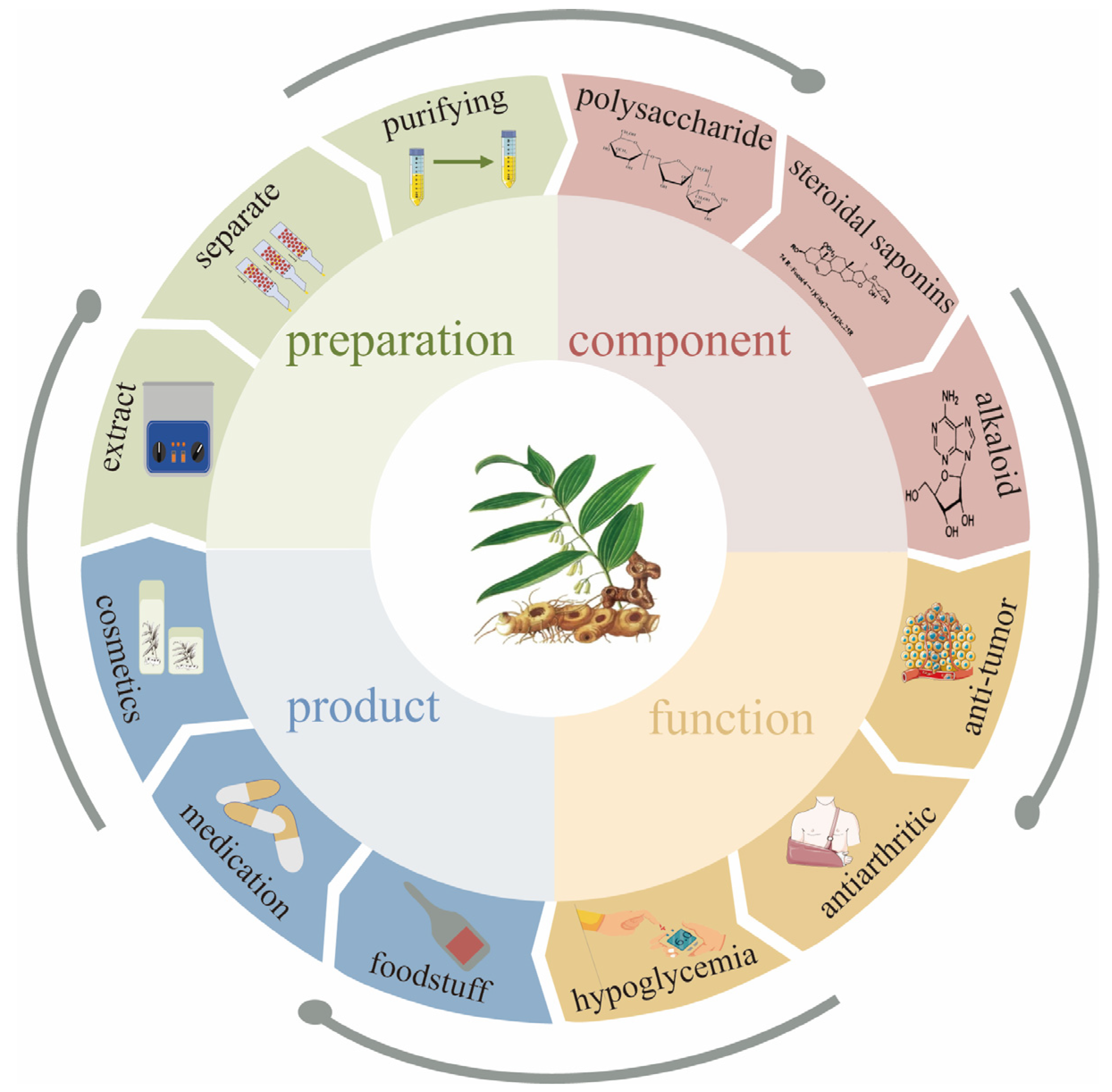
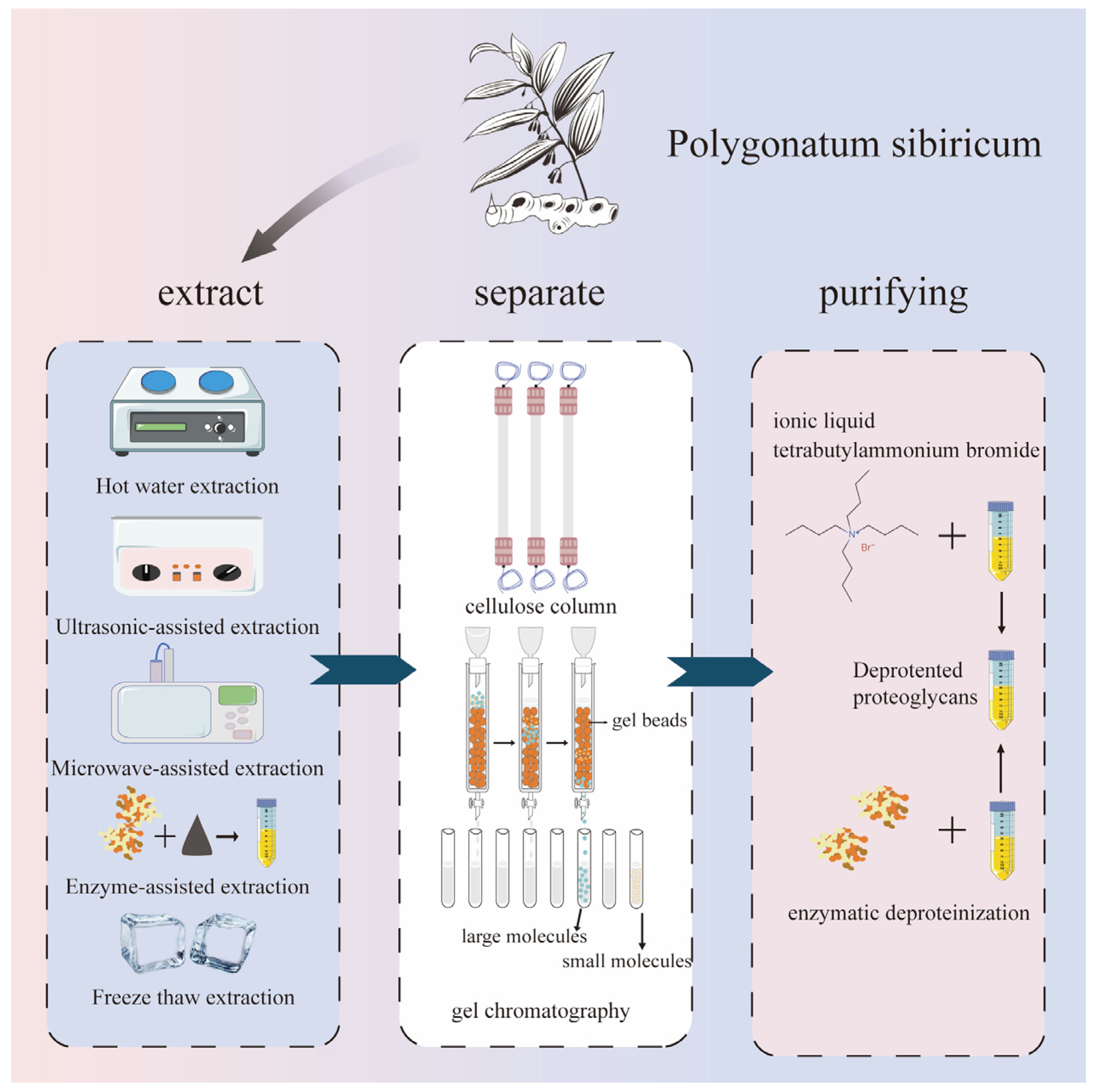

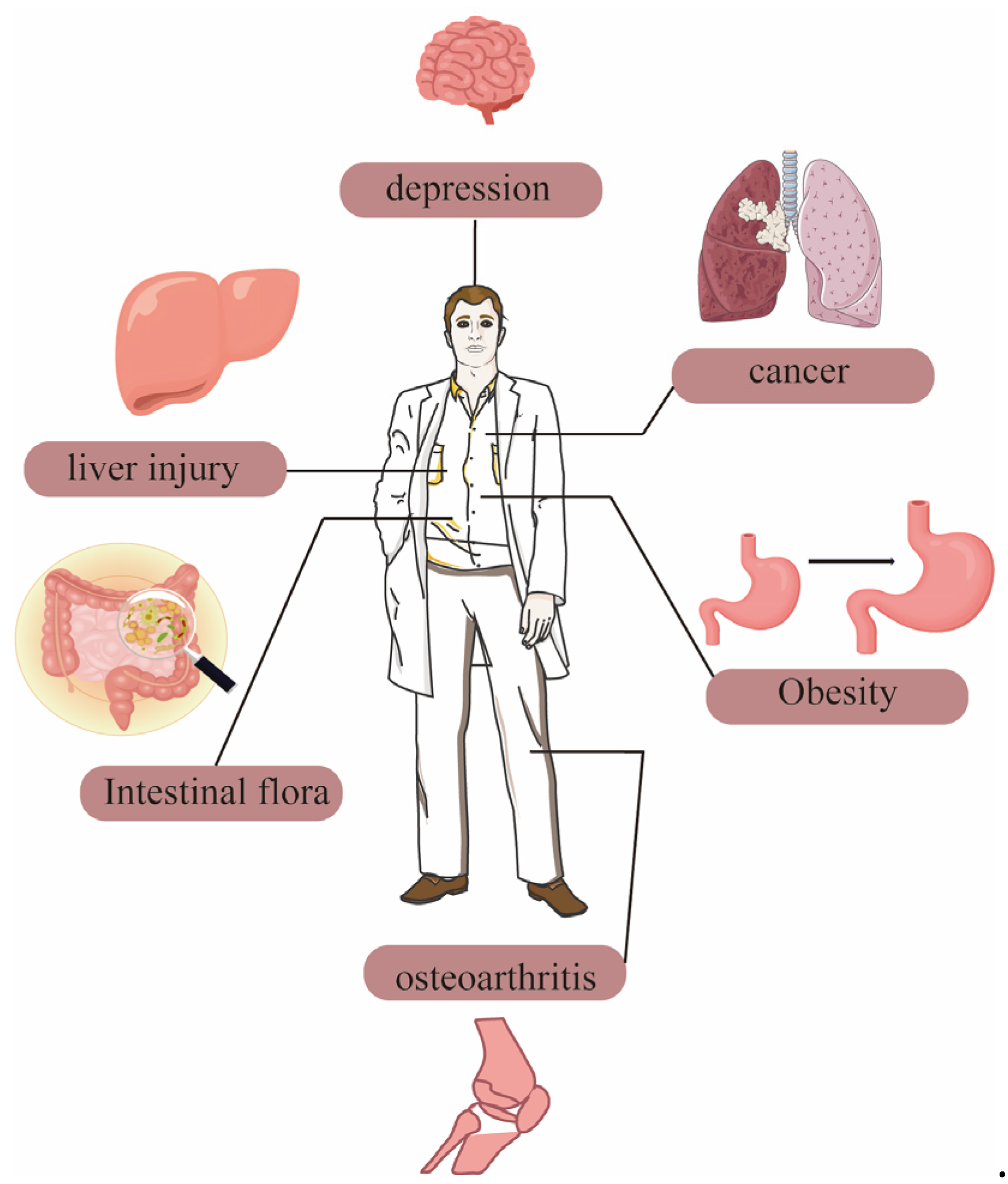
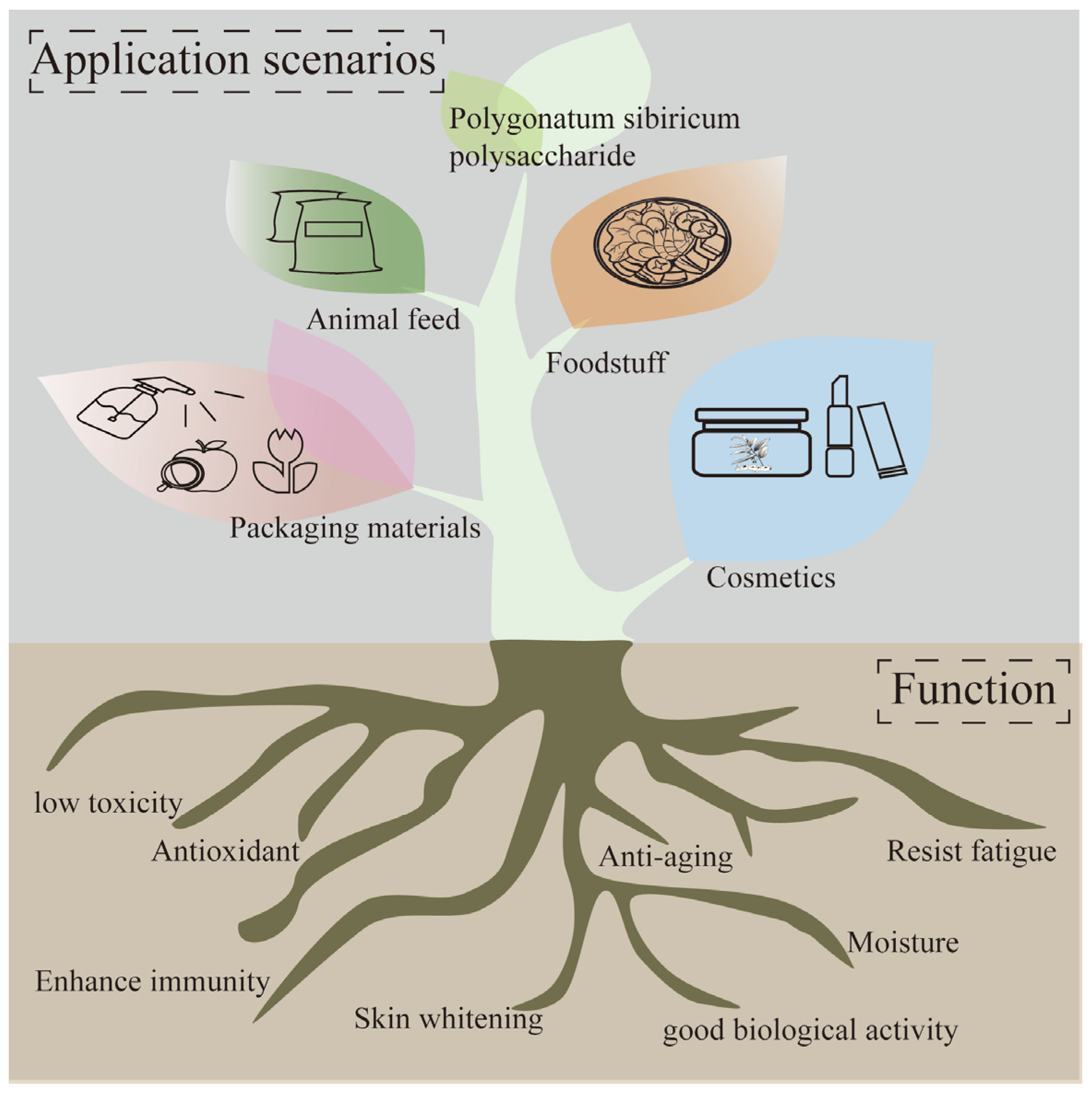
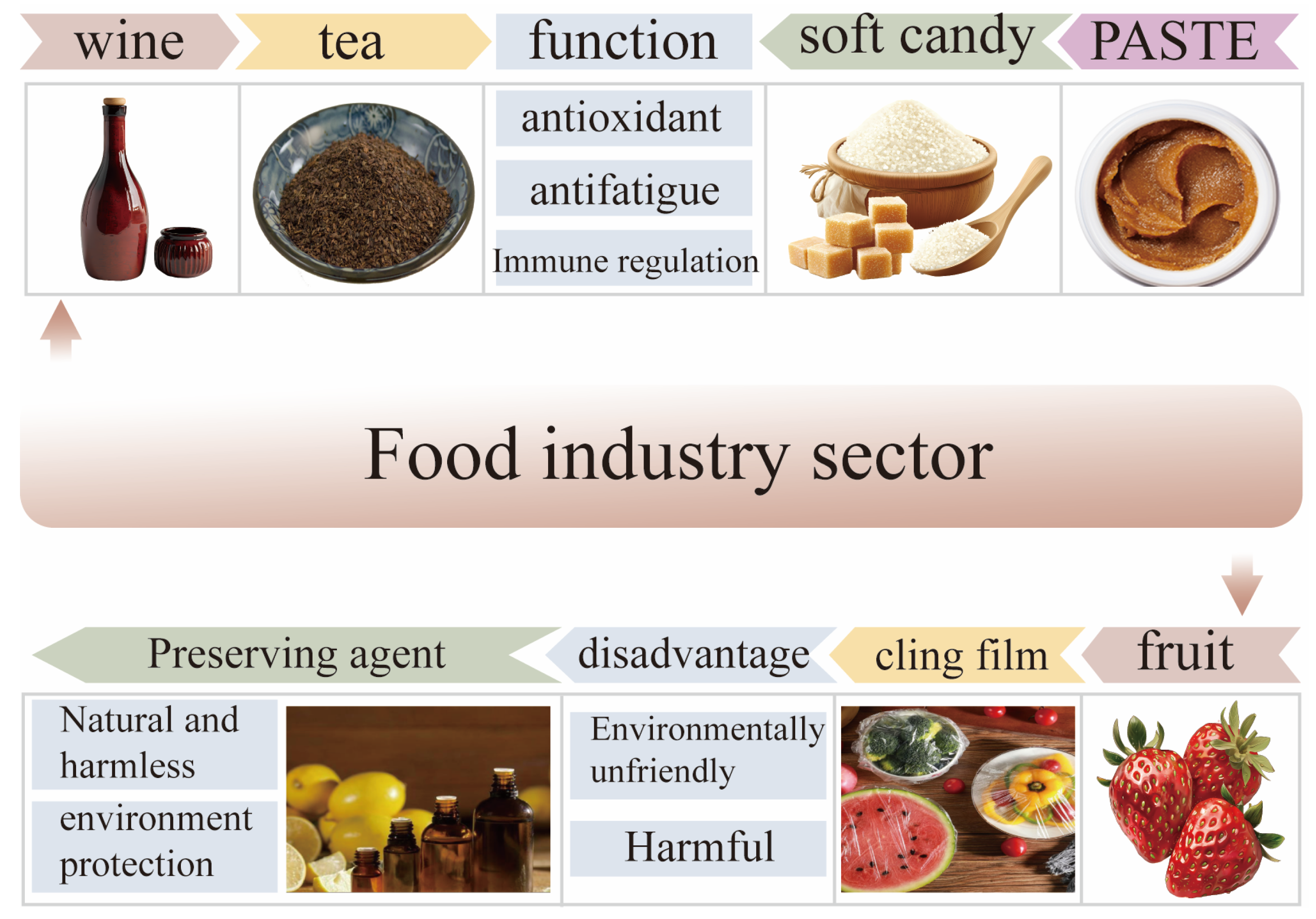
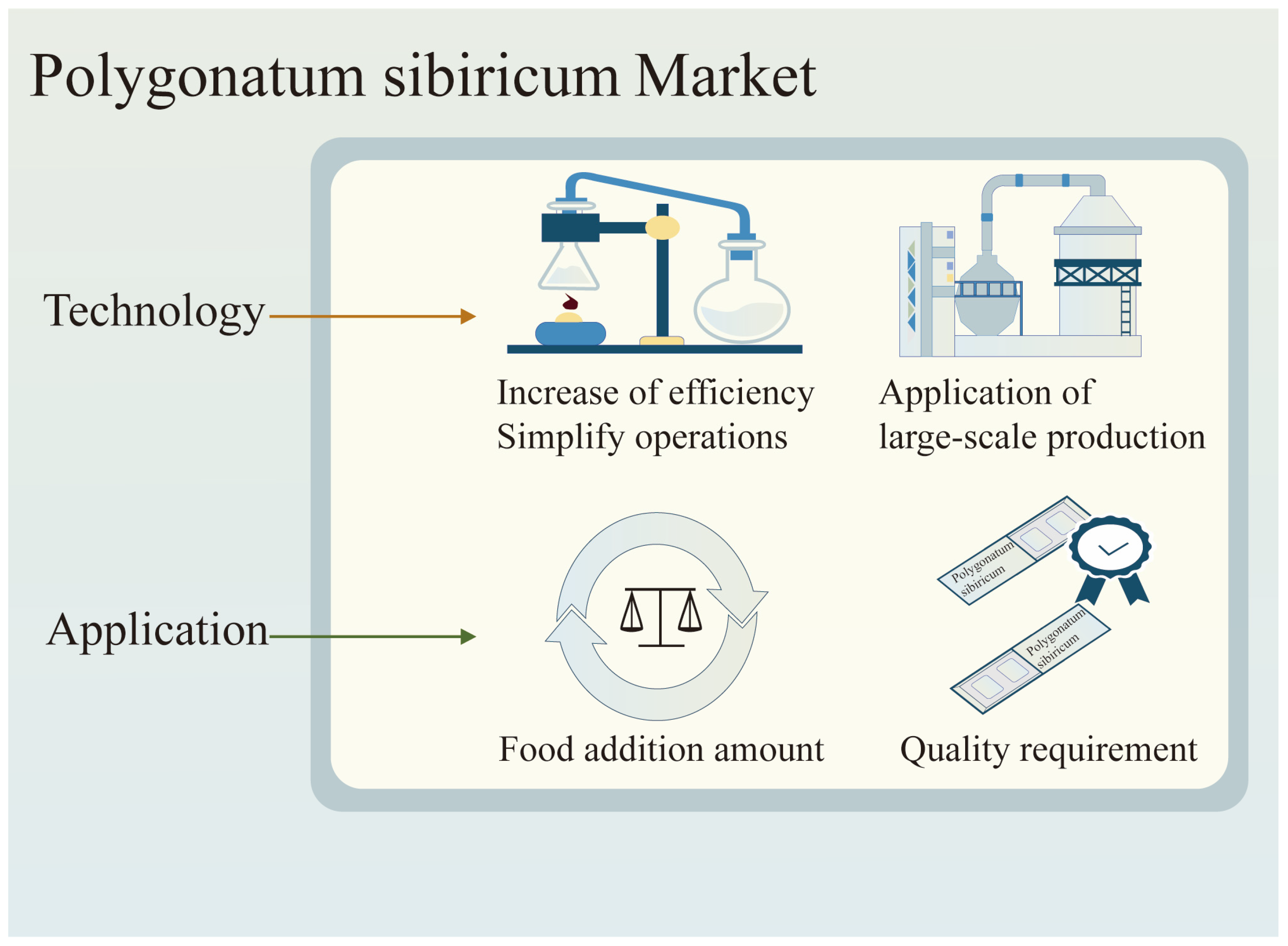
| Source | Extraction Method | Molecular Weight (Da) | Extraction Efficiency | Characteristics | References |
|---|---|---|---|---|---|
| Polygonatum sibiricum | Ethanol ultrasonic extraction | 5.55% | Potential to become AChE inhibitors for the treatment of Alzheimer’s disease | [17] | |
| Polygonatum sibiricum | Enzyme-assisted extraction | 3.926 × 103 | 12.00% | Maintains lipid-lowering and antioxidant activities | [21] |
| Polygonatum sibiricum | Hot water extraction | 4.025 × 103 | 14.86 | Maintains the antioxidant activity of polysaccharides | [21] |
| Polygonatum cyrtonema | Freeze–thaw method | 65.76% | Significant antioxidant activity | [22] | |
| Polygonatum kingianum | Natural deep eutectic solvent extraction method | 29.69% | Maintains immune regulatory function | [24] | |
| Polygonatum sibiricum | Ultrasound-assisted extraction Deep eutectic solvent | 4.6 × 103 | 43.61% | Maintains the antioxidant activity of polysaccharides | [25] |
| Polygonatum sibiricum | radiation-induced degradation and extraction | 32.40% | Excellent reactive oxygen species scavenging ability | [26] | |
| Polygonatum sibiricum | Water extraction Microwave-assisted degradation | 2.33 × 103 | 21.5% | Maintains good antioxidant activity | [27] |
| Category | Component Name | Molecular Weight (Da) | Monosaccharide Composition | Sugar Chain | References |
|---|---|---|---|---|---|
| Polygonatum sibiricum | PSP-N-b-1 | 6.3 × 103 | Man, GlcA, Rha, GalA, Glc and Ara | [32] | |
| PSP-N-b-2 | 5.78 × 103 | ||||
| PSP-N-c-1 | 3.45 × 103 | ||||
| PSP-NP | 4.30 × 104 | Gal, Man, Glc | 1,4-β-D-Gal, 1,4,6-β-D-Gal, T-α-D-Man, 1,4-α-D-Glc, T-α-D-Glc | [33] | |
| PSP-1 | 3.865 × 104 | Glc | →4-α-D-Glcp-1→backbone with the substitution at O-6 with the β-D-Glcp-1→residues | [34] | |
| Polygonatum kingianum | PKP-s1 | 1.405 × 104 | Glc, Man, GalA, Gal, GlcA, Ara | polysaccharide component is mainly composed of glucose connected to (→1), (1→2), (1→6), and (1→4), as well as mannose connected to (1→2) | [35] |
| Polygonatum cyrtonema | NPCP | 3.2 × 103 | Glu, Gal | →1)-α-D-Glc-(4→1)-β-D-Gal-(3→) | [36] |
| DPC1 | 3.803 × 103 | Fru, Glc | (2→6)-linked β-D-Fruf residue backbone with an internal α-D-Glcp residue and two (2→1)linked β-D-Fruf residue branches | [37] | |
| PPC1 | 7.019 × 103 | Gal | (1→4)-β-D-galactan branched with a single β-dgalactose at C-6 at about every nine residues in its main chain | ||
| PCP | 6.710 × 104 | Ara, Gal, Glc, Xyl, GalA | [38] | ||
| PCP | 8.5 × 103 | Glc, Fru | →6)-β-D-Fruf-(2→,→1,6)-β-D-Fruf-(2→,→1)-β-D-Fruf-(2→,β-D-Fruf-(2→,and →6)-α-D-Galp-(1→ | [39] |
| Category | Component | Action Concentration (mg/kg/d) | Action Site | Pharmacological Activity | References |
|---|---|---|---|---|---|
| Polygonatum sibiricum | PSP | 400 | Knee osteoarthritis | PSP exerts anti-inflammatory and other effects in knee osteoarthritis by inhibiting the TLR2/NF-κ B signaling pathway. | [10] |
| Polygonatum sibiricum Red (leaves) | PSPs | 200 | Intestine | PsPs can increase the production of SCFAs by regulating the gut microbiota and have a positive prebiotic effect to regulate the gut. | [13] |
| Polygonatum sibiricum | PSP-H | 100–400 | Reduces insulin resistance index, increases OGTT and serum insulin levels, improves lipid metabolism, and enhances glucose metabolism in T2DM mice, thereby reducing blood glucose levels. | [46] | |
| Polygonatum sibiricum | PSPW | 50–200 | PSPW may increase the phosphorylation levels of PI3K and Akt in the liver and decrease the phosphorylation levels of FoxO 1 and GSK 3 β by mediating the PI3K/AKT signaling pathway, thereby promoting improvement in the blood sugar in type 2 diabetes mice. | [47] | |
| Polygonatum sibiricum | PSP | In vitro antioxidant | As the number of cooking cycles increases, the ability of PSP to scavenge DPPH free radicals gradually increases, and its IC 50 decreases from 3.30 ± 0.05 mg/mL to 0.11 ± 0.01 mg/mL at the ninth cooking cycle. | [49] | |
| Polygonatum sibiricum | PSP | 100–400 | PSP plays a positive regulatory role in cellular and humoral immunity both in vivo and in vitro, and it can activate non-specific and specific immune responses (no immune-enhancing effect at low doses). | [51] | |
| Polygonatum sibiricum | PSP | 200 | Tumor | PSP exerts an immune-enhancing effect against lung cancer by activating TLR4 receptors and downstream MAPK/NF-κ B signaling pathways. | [52] |
| Polygonatum sibiricum | PSP | 100–400 | PSP may prevent depressive-like behavior by reducing reactive oxygen species, hypercortisolism, and the inflammatory response and by decreasing synaptic and cellular damage. | [56] | |
| Polygonatum cyrtonema Hua | PSP | 400 | PSP exerts antidepressant effects by regulating the oxidative stress-induced calpain 1-NLRP3 signaling axis. | [57] | |
| Polygonatum sibiricum | PSP-N-c-1 | 100–400 | Liver | The potential protective effect of PSP-N-c-1 on the liver may be related to the activation of the Nrf2-mediated signaling pathway and regulation of the TLR4-mediated NF-κ B signaling pathway, which can alleviate oxidative stress and the inflammatory response. | [58] |
Disclaimer/Publisher’s Note: The statements, opinions and data contained in all publications are solely those of the individual author(s) and contributor(s) and not of MDPI and/or the editor(s). MDPI and/or the editor(s) disclaim responsibility for any injury to people or property resulting from any ideas, methods, instructions or products referred to in the content. |
© 2025 by the authors. Licensee MDPI, Basel, Switzerland. This article is an open access article distributed under the terms and conditions of the Creative Commons Attribution (CC BY) license (https://creativecommons.org/licenses/by/4.0/).
Share and Cite
Li, P.; Yao, H.; Yue, H.; Huang, J.; Wang, Q.; Ding, C.; Ma, L.; Liu, X.; Yang, M. Preparation, Structure, Function, and Application of Dietary Polysaccharides from Polygonatum sibiricum in the Food Industry: A Review. Molecules 2025, 30, 1098. https://doi.org/10.3390/molecules30051098
Li P, Yao H, Yue H, Huang J, Wang Q, Ding C, Ma L, Liu X, Yang M. Preparation, Structure, Function, and Application of Dietary Polysaccharides from Polygonatum sibiricum in the Food Industry: A Review. Molecules. 2025; 30(5):1098. https://doi.org/10.3390/molecules30051098
Chicago/Turabian StyleLi, Peilin, Huimin Yao, Hao Yue, Jiali Huang, Qi Wang, Chuanbo Ding, Lina Ma, Xinglong Liu, and Min Yang. 2025. "Preparation, Structure, Function, and Application of Dietary Polysaccharides from Polygonatum sibiricum in the Food Industry: A Review" Molecules 30, no. 5: 1098. https://doi.org/10.3390/molecules30051098
APA StyleLi, P., Yao, H., Yue, H., Huang, J., Wang, Q., Ding, C., Ma, L., Liu, X., & Yang, M. (2025). Preparation, Structure, Function, and Application of Dietary Polysaccharides from Polygonatum sibiricum in the Food Industry: A Review. Molecules, 30(5), 1098. https://doi.org/10.3390/molecules30051098





